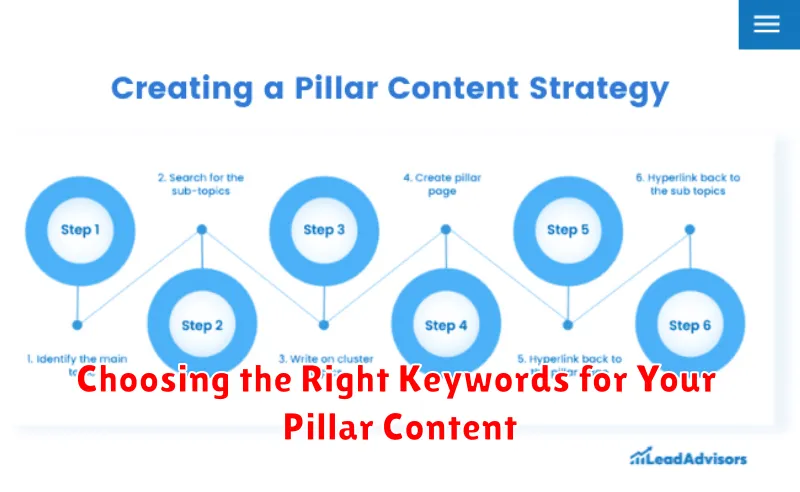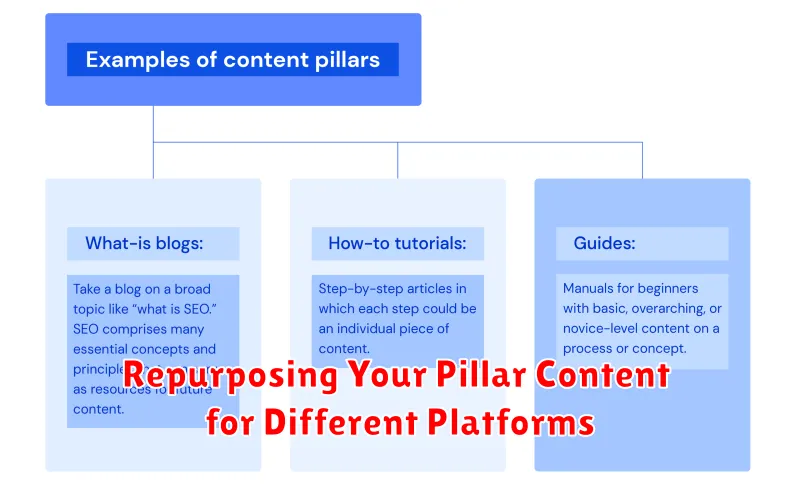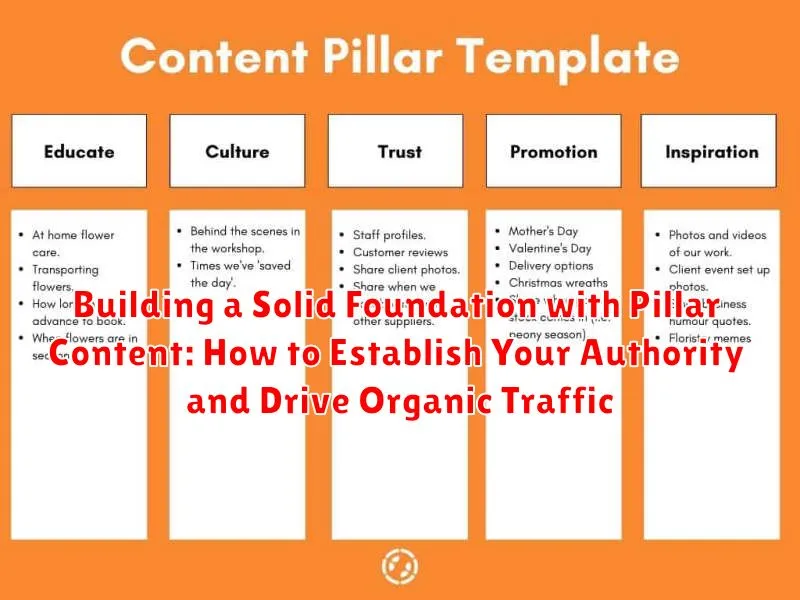In the ever-evolving digital landscape, establishing a strong online presence is paramount for businesses and individuals alike. Creating high-quality content that resonates with your target audience is essential for driving organic traffic and building authority in your niche. One of the most effective strategies for achieving this is by developing pillar content. Pillar content serves as a comprehensive and authoritative resource on a core topic, acting as a central hub that supports and links to other related content pieces. By focusing on creating pillar content, you can effectively position yourself as an expert, attract a larger audience, and ultimately achieve your online goals.
This comprehensive guide will delve into the intricacies of building a solid foundation with pillar content. We will explore what pillar content is, why it’s crucial for your online strategy, and how to create compelling and effective pillar content that will attract and engage your target audience. Learn how pillar content can establish your authority, drive organic traffic to your website, and contribute significantly to your overall content marketing success. We will cover key aspects such as topic selection, content structure, optimization strategies, and promotion techniques to ensure your pillar content reaches its full potential. Start building your solid foundation today and transform your online presence with the power of pillar content.
What is Pillar Content and Why is it Important?
Pillar content serves as a comprehensive and authoritative resource on a core topic relevant to your business. Think of it as a central hub of information, offering in-depth knowledge and insights. It differs from typical blog posts or articles by delving deeper into a subject and acting as a foundational piece for related content.
The importance of pillar content lies in its ability to establish your authority and boost your organic traffic. By providing valuable, detailed information, you position yourself as an expert in your field. This attracts readers seeking reliable and informative content. Furthermore, pillar content acts as a magnet for search engines. By targeting relevant keywords and offering substantial value, you improve your search engine rankings, driving more organic traffic to your website.
Pillar content also plays a crucial role in content strategy by supporting other types of content. Shorter blog posts, infographics, and social media updates can all link back to your pillar content, creating a cohesive content ecosystem and further solidifying your expertise.
Different Types of Pillar Content
Pillar content comes in various formats, each serving a unique purpose in educating your audience and establishing your expertise. Choosing the right format depends on your topic and target audience.
1. How-to Guides: These comprehensive guides provide step-by-step instructions on completing a specific task or achieving a particular outcome. They are highly actionable and offer practical value to the reader.
2. Ultimate Guides: Ultimate guides offer a deep dive into a particular topic, covering all aspects and providing in-depth information. They are designed to be the definitive resource on a subject.
3. Resource Lists: These curated lists compile valuable resources, tools, and information related to a specific topic. They offer a convenient hub for users seeking information and solutions.
4. Case Studies: Case studies showcase real-world examples of how a product or service has helped clients achieve success. They provide compelling evidence of your expertise and build trust.
How to Create Effective Pillar Content
Creating effective pillar content requires a strategic approach. Begin by thoroughly researching your topic. Ensure your information is accurate, up-to-date, and comprehensive. This builds credibility and positions you as an authority.
Focus on in-depth analysis, going beyond surface-level explanations. Provide valuable insights and unique perspectives that your audience won’t find elsewhere. This differentiates your content and encourages engagement.
Next, organize your content logically. Use clear headings, subheadings, and bullet points to enhance readability and make it easy for readers to navigate the information. A well-structured piece keeps readers engaged and encourages them to explore further.
Finally, maintain a consistent publishing schedule. Regularly updating your pillar content with fresh information keeps it relevant and signals to search engines that your site is active and authoritative. This contributes to improved search engine rankings and sustained organic traffic growth.
Choosing the Right Keywords for Your Pillar Content

Keyword research is crucial for pillar content success. Relevant keywords connect your content with your target audience’s searches. Choosing the right keywords ensures your pillar content ranks well in search engine results and attracts organic traffic.
Start by identifying a primary keyword that broadly represents your topic. This keyword should have a high search volume but not be overly competitive. Then, research related long-tail keywords. These are longer, more specific phrases that address particular aspects of your topic. Long-tail keywords often have lower search volume but higher conversion rates.
Use keyword research tools to analyze search volume, competition, and keyword relevance. Consider user intent when selecting keywords. Ask yourself what information users are seeking when they use a particular keyword. Align your keywords with user intent to provide valuable and relevant content.
Structuring Your Pillar Content for Maximum Impact
Strategic structuring is crucial for pillar content to effectively deliver value and engage readers. A logical flow enhances comprehension and encourages readers to explore the topic thoroughly. Consider these structural elements:
Introduction
Begin with a compelling introduction that clearly states the topic’s scope and its importance to the reader. Briefly outline what the content will cover.
Sections and Subsections
Divide your content into logical sections and subsections using descriptive headings. This improves readability and allows readers to quickly navigate to specific areas of interest.
Visual Hierarchy
Utilize formatting elements such as bold text, italics, and bulleted or numbered lists to emphasize key points and break up large blocks of text, improving visual appeal and comprehension.
Summarize key takeaways and reinforce the core message of your pillar content. This provides a sense of closure and encourages readers to further explore related topics.
Promoting Your Pillar Content to Reach a Wider Audience
Creating high-quality pillar content is only the first step. To truly maximize its impact, you need a robust promotion strategy. This involves utilizing various channels to reach your target audience and drive traffic back to your core content.
Social media is a powerful tool for promotion. Share snippets, key takeaways, and engaging visuals related to your pillar content across platforms like Twitter, LinkedIn, and Facebook. Tailor your messaging to each platform’s specific audience.
Email marketing allows you to directly reach subscribers who have expressed interest in your content. Announce the release of your pillar content and highlight its value proposition. Consider segmenting your audience to deliver more targeted messaging.
Paid advertising can significantly amplify your reach. Platforms like Google Ads and social media advertising allow you to target specific demographics and interests. Even a modest budget can drive significant traffic to your pillar content.
Measuring the Success of Your Pillar Content Strategy
Measuring the effectiveness of your pillar content is crucial for understanding its impact and making data-driven improvements. Key Performance Indicators (KPIs) provide quantifiable metrics to track progress and identify areas for optimization.
Website analytics offer valuable insights into user engagement. Track metrics such as page views, time on page, and bounce rate to gauge audience interest and content effectiveness. A high bounce rate might suggest a need to improve content relevance or readability.
Social media engagement is another important indicator. Monitor shares, likes, and comments to understand how well your pillar content resonates with your target audience on different platforms. This data can inform your social media promotion strategy.
Backlinks are a key indicator of authority and search engine ranking potential. Track the number and quality of backlinks your pillar content receives. SEO tools can help you identify backlink opportunities and analyze your backlink profile.
Finally, assess lead generation. If your pillar content is designed to drive leads, track form submissions, email sign-ups, or other relevant conversions to measure its effectiveness in achieving this goal.
Repurposing Your Pillar Content for Different Platforms

Repurposing your pillar content allows you to maximize its reach and impact across various platforms, catering to different audience preferences and consumption habits. This multifaceted approach reinforces your key message and expands your brand’s visibility.
Consider transforming your core pillar content into various formats. For example, a lengthy blog post can be broken down into a series of shorter social media posts, focusing on individual key takeaways. Data and insights can be visualized as infographics for easier sharing and understanding.
Key repurposing opportunities include creating:
- Short videos for platforms like YouTube or TikTok.
- Audio clips for podcasts or social media stories.
- Quote graphics for visual platforms like Instagram and Pinterest.
- Email newsletter segments summarizing key points.
- Slide decks for presentations or online courses.
By strategically repurposing your pillar content, you can ensure your message resonates with a wider audience and strengthens your position as a thought leader in your field.
Common Mistakes to Avoid When Creating Pillar Content
Creating effective pillar content requires careful planning and execution. Avoiding these common mistakes can significantly improve your content’s performance and impact.
Lack of in-depth research
Thorough research is crucial. Failing to adequately research your topic can lead to superficial content that lacks valuable insights and fails to establish your authority.
Ignoring keyword research
Understanding relevant keywords is essential for organic visibility. Neglecting keyword research can hinder your content’s ability to rank in search engine results and reach your target audience.
Overlooking content promotion
Creating high-quality content is only half the battle. Promoting your pillar content across various channels is crucial for maximizing its reach and impact. Without a solid promotional strategy, your valuable content may go unnoticed.
Failing to update your content
The digital landscape is constantly evolving. Ensure your pillar content remains relevant and authoritative by regularly updating it with fresh insights and information.

